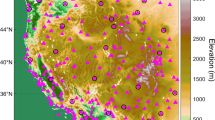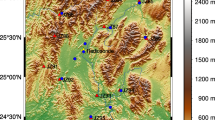Abstract
Water vapor plays an important role in Earth’s weather and climate processes and energy transfer. Plenty of techniques have developed to monitor precipitable water vapor (PWV), but joint use of different techniques has some problems, including systematic biases, different spatiotemporal coverages and resolutions among different datasets. To address the above problems and improve the data utilization, we propose to use a generalized regression neural network (GRNN) to fuse PWVs from Global Navigation Satellite System (GNSS), Moderate-Resolution Imaging Spectroradiometer (MODIS), and European Centre for Medium‐Range Weather Forecasts Reanalysis 5 (ERA5). The core idea of this method is to use the high-quality GNSS PWV to calibrate and optimize the relatively low-quality MODIS and ERA5 PWV through the constructed GRNNs. Using the proposed method, we generated more than 400 PWV maps that combine GNSS, MODIS, and ERA5 PWVs in North America in 2018. Results show that the overall bias, standard deviation (STD), and root-mean-square (RMS) error are 0.0 mm, 2.1 mm, and 2.2 mm for the improved MODIS PWV, and 0.0 mm, 1.6 mm, and 1.6 mm for the improved ERA5 PWV. Compared to the original MODIS and ERA5 PWV, the total improvements are 37.1% and 15.8% in terms of RMS. The RMS improvements are mainly contributed from the calibration of bias for the MODIS PWV and optimization for the ERA5 PWV. It also demonstrates that the original MODIS PWV tends to be greater than the GNSS PWV while the ERA5 PWV has very small biases. After calibration and optimization, the correlation coefficients between the modified PWV and the GNSS PWV are 0.96 for the MODIS PWV and 0.98 for the ERA5 PWV. The proposed method also diminishes the temporal and spatial variations in accuracy, generating homogeneous PWV products. Since the biases among the three datasets are well removed and data accuracies are improved to the same level, they are thus easily fused and jointly used.














Similar content being viewed by others
Data Availability
The GNSS PWV data used in this paper can be freely accessed at https://www.suominet.ucar.edu/data/pwvConusHourly/. The MODIS PWV data can be accessed at https://ladsweb.modaps.eosdis.nasa.gov/archive/allData/61/. The ECMWF ERA5 PWV data can be accessed at https://cds.climate.copernicus.eu/cdsapp#!/dataset/reanalysis-era5-single-levels?tab=form. The codes associated with the spherical cap harmonic analysis are available upon request to Dr. Bao Zhang (sggzb@whu.edu.cn).
References
Alshawaf F, Fersch B, Hinz S, Kunstmann H, Mayer M, Meyer FJ (2015) Water vapor mapping by fusing InSAR and GNSS remote sensing data and atmospheric simulations. Hydrol Earth Syst Sci 19(12):4747–4764
Barindelli S, Realini E, Venuti G, Fermi A, Gatti A (2018) Detection of water vapor time variations associated with heavy rain in northern Italy by geodetic and low-cost GNSS receivers. Earth, Planet Sp 70(1):28
Bevis M, Businger S, Herring TA, Rocken C, Anthes RA, Ware RH (1992) GPS meteorology: remote sensing of atmospheric water vapor using the global positioning system. J Geophys Res: Atmos 97(D14):15787–15801
Bevis M, Businger S, Chiswell S, Herring TA, Anthes RA, Rocken C, Ware RH (1994) GPS meteorology: Mapping zenith wet delays onto precipitable water. J Appl Meteorol 33(3):379–386
Cadeddu MP, Liljegren JC, Pazmany AL (2007) Measurements and retrievals from a new 183-GHz water-vapor radiometer in the Arctic. IEEE Trans Geosci Remote Sens 45(7):2207–2215
Chen B, Liu Z (2016) Global water vapor variability and trend from the latest 36 year (1979 to 2014) data of ECMWF and NCEP reanalyses, radiosonde, GPS, and microwave satellite. J Geophys Res: Atmos 121(19):11–442
Cigizoglu HK, Alp M (2006) Generalized regression neural network in modelling river sediment yield. Adv Eng Softw 37(2):63–68
Dach, R., Hugentobler, U., Fridez, P., & Meindl, M. (2007). Bernese GPS software version 5.0. Astronomical Institute, University of Bern, 640, 114.
Dou SB, Song SL, Zhou WL, Liu ZM, Chen QM, Zheng WM, Chen HC (2018) Study on the water vapor radiometer calibration with GPS data. AcASn 59(6):53
Gao B (2015) MODIS Atmosphere L2 Water Vapor Product. NASA MODIS Adapt Proc Syst, Goddard Sp Fl Center, USA,. https://doi.org/10.5067/MODIS/MOD05_L2.006
Gao BC, Kaufman YJ (1998) The MODIS near-IR water vapor algorithm. Algorithm Theoretical Basis Document, ATBD-MOD, p 5
Gao BC, Kaufman YJ (2003) Water vapor retrievals using moderate resolution imaging Spectroradiometer MODIS near-infrared channels. J Geophys Res Atmos. https://doi.org/10.1029/2002JD003023
Gui K, Che H, Chen Q, Zeng Z, Liu H, Wang Y, Zhang X (2017) Evaluation of radiosonde, MODIS-NIR-clear, and AERONET precipitable water vapor using IGS ground-based GPS measurements over China. Atmos Res 197:461–473
Hersbach H, Bell B, Berrisford P, Hirahara S, Horányi A, Muñoz-Sabater J, Simmons A (2020) The ERA5 global reanalysis. Q J R Meteorol Soc. https://doi.org/10.1002/qj.3803
He J, Liu Z (2019) Comparison of Satellite-derived precipitable water vapor through Near-infrared remote sensing channels. IEEE Trans Geosci Remote Sens 57(12):10252–10262
He J, Liu Z (2020) Refining MODIS NIR atmospheric water vapor retrieval algorithm using GPS-derived water vapor data. IEEE Trans Geosci Remote Sens. https://doi.org/10.1109/TGRS.2020.3016655
Jarvis, A., Reuter, H. I., Nelson, A., Guevara, E. (2008) Hole-filled seamless SRTM data V4, international centre for tropical agriculture (CIAT), available from http://srtm.csi.cgiar.org.
Jiang P, Ye S, Chen D, Liu Y, Xia P (2016) Retrieving precipitable water vapor data using GPS zenith delays and global reanalysis data in China. Remote Sens 8(5):389
Kaufman YJ, Gao BC (1992) Remote sensing of water vapor in the near IR from EOS/MODIS. IEEE Trans Geosci Remote Sens 30(5):871–884
Kim B, Lee DW, Park KY, Choi SR, Choi S (2004) Prediction of plasma etching using a randomized generalized regression neural network. Vacuum 76(1):37–43
King MD, Menzel WP, Kaufman YJ, Tanré D, Gao BC, Platnick S, Hubanks PA (2003) Cloud and aerosol properties, precipitable water, and profiles of temperature and water vapor from MODIS. IEEE Trans Geosci Remote Sens 41(2):442–458
Lindenbergh, R., Van der Marel, H., Keshin, M., & De Haan, S. (2009). Validating time series of a combined GPS and MERIS Integrated Water Vapor product. In Proceedings 2nd MERIS/(A) ATSR User Workshop, September 22–26, 2008 ESA/ESRIN Frascati (Rome), 2009 (NB: small correction applied wrt Proceedings version)
Li Z, Muller JP, Cross P (2003) Comparison of precipitable water vapor derived from radiosonde, GPS, and Moderate-resolution imaging spectroradiometer measurements. J Geophy Res Atmos. https://doi.org/10.1029/2003JD003372
Li, Z. (2004). Production of regional 1 km x 1 km water vapor fields through the integration of GPS and MODIS data. Online available at http://eprints.gla.ac.uk/48158/
Li T, Shen H, Yuan Q, Zhang X, Zhang L (2017a) Estimating ground-level PM25 by fusing satellite and station observations: a geo-intelligent deep learning approach. Geophys Res Lett 44(23):11–985
Li T, Shen H, Zeng C, Yuan Q, Zhang L (2017b) Point-surface fusion of station measurements and satellite observations for mapping PM2.5 distribution in China: methods and assessment. Atmos Environ 152:477–489
Liu J, Sun Z, Liang H, Xu X, Wu P (2005) Precipitable water vapor on the Tibetan Plateau estimated by GPS, water vapor radiometer, radiosonde, and numerical weather prediction analysis and its impact on the radiation budget. J Geophys Res Atmos. https://doi.org/10.1029/2004JD005715
Liu Z, Wong MS, Nichol J, Chan PW (2013) A multi-sensor study of water vapour from radiosonde, MODIS and AERONET: a case study of Hong Kong. Int J Climatol 33(1):109–120
Miloshevich LM, Vömel H, Whiteman DN, Leblanc T (2009) Accuracy assessment and correction of Vaisala RS92 radiosonde water vapor measurements. J Geophys Res Atmos. https://doi.org/10.1029/2008JD011565
Ralph FM, Iacobellis SF, Neiman PJ, Cordeira JM, Spackman JR, Waliser DE, Fairall C (2017) Dropsonde observations of total integrated water vapor transport within North Pacific atmospheric rivers. J Hydrometeorol 18(9):2577–2596
Ren H, Du C, Liu R, Qin Q, Yan G, Li ZL, Meng J (2015) Atmospheric water vapor retrieval from Landsat 8 thermal infrared images. J Geophys Res: Atmos 120(5):1723–1738
Reuter HI, Nelson A, Jarvis A (2007) An evaluation of void-filling interpolation methods for SRTM data. Int J Geogr Inform Sci 21(9):983–1008
Rinke A, Segger B, Crewell S, Maturilli M, Naakka T, Nygård T, Keller J (2019) Trends of vertically integrated water vapor over the arctic during 1979–2016: consistent moistening all over? J Clim 32(18):6097–6116
Rocken C, Ware R, Van Hove T, Solheim F, Alber C, Johnson J, Businger S (1993) Sensing atmospheric water vapor with the Global Positioning System. Geophys Res Lett 20(23):2631–2634
Rocken C, Van Hove T, Ware R (1997) Near real-time GPS sensing of atmospheric water vapor. Geophysical research letters 24(24):3221–3224
Rodriguez JD, Perez A, Lozano JA (2009) Sensitivity analysis of k-fold cross validation in prediction error estimation. IEEE Tran Pattern Anal Mach Intell 32(3):569–575
Saastamoinen J (1972) Atmospheric correction for the troposphere and stratosphere in radio ranging satellites. Artif Satell Geod 15:247–251
Sherwood SC, Roca R, Weckwerth TM, Andronova NG (2010) Tropospheric water vapor, convection, and climate. Rev Geophys. https://doi.org/10.1029/2009RG000301
Specht DF (1991) A general regression neural network. IEEE Trans Neural Netw 2(6):568–576
Teke K, Nilsson T, Böhm J, Hobiger T, Steigenberger P, García-Espada S, Willis P (2013) Troposphere delays from space geodetic techniques, water vapor radiometers, and numerical weather models over a series of continuous VLBI campaigns. J Geod 87(10–12):981–1001
Wang J, Dai A, Mears C (2016) Global water vapor trend from 1988 to 2011 and its diurnal asymmetry based on GPS, radiosonde, and microwave satellite measurements. J Clim 29(14):5205–5222
Wang J, Wu Z, Semmling M, Zus F, Gerland S, Ramatschi M, Schuh H (2019) Retrieving precipitable water vapor from shipborne multi-GNSS observations. Geophys Res Lett 46(9):5000–5008
Ware RH, Fulker DW, Stein SA, Anderson DN, Avery SK, Clark RD, Sorooshian S (2000) SuomiNet: A real-time national GPS network for atmospheric research and education. Bull Am Meteorol Soc 81(4):677–694
Xu H, Yuan Q, Li T, Shen H, Zhang L, Jiang H (2018) Quality improvement of satellite soil moisture products by fusing with in-situ measurements and GNSS-R estimates in the western continental US. Remote Sens 10(9):1351
Yuan Q, Li S, Yue L, Li T, Shen H, Zhang L (2019) Monitoring the variation of vegetation water content with machine learning methods: point-surface fusion of MODIS products and GNSS-IR observations. Remote Sens 11(12):1440
Yuan Q, Xu H, Li T, Shen H, Zhang L (2020) Estimating surface soil moisture from satellite observations using a generalized regression neural network trained on sparse ground-based measurements in the continental US. J Hydrol 580:124351
Zhang Y, Cai C, Chen B, Dai W (2019a) Consistency evaluation of precipitable water vapor derived from ERA5, ERA-Interim, GNSS, and radiosondes over China. Radio Sci 54(7):561–571
Zhang B, Yao Y, Xin L, Xu X (2019b) Precipitable water vapor fusion: an approach based on spherical cap harmonic analysis and Helmert variance component estimation. J Geod 93(12):2605–2620
Acknowledgements
We thank University Corporation for Atmospheric Research (UCAR) for providing the GNSS PWV data and National Aeronautics and Space Administration (NASA) for providing the MODIS PWV products and the European Centre for Medium-Range Weather Forecasts (ECMWF) for providing the ERA5 reanalysis data. This work is jointly supported by the National Natural Science Foundation of China (41704004; 42074035), the Fundamental Research Funds for the Central Universities (2042020kf0009), and the China Postdoctoral Science Foundation (2018M630880; 2019T120687). This work is also partially supported by Key Technology Projects in Transportation Industry (2019-MS1-013) and the Department of Transportation of Zhejiang Province (2019-GCKY-02).
Author information
Authors and Affiliations
Contributions
BZ and YY together designed the research and proposed the solutions. BZ performed the research and wrote the paper. YY provided valuable suggestions.
Corresponding author
Rights and permissions
About this article
Cite this article
Zhang, B., Yao, Y. Precipitable water vapor fusion based on a generalized regression neural network. J Geod 95, 36 (2021). https://doi.org/10.1007/s00190-021-01482-z
Received:
Accepted:
Published:
DOI: https://doi.org/10.1007/s00190-021-01482-z




